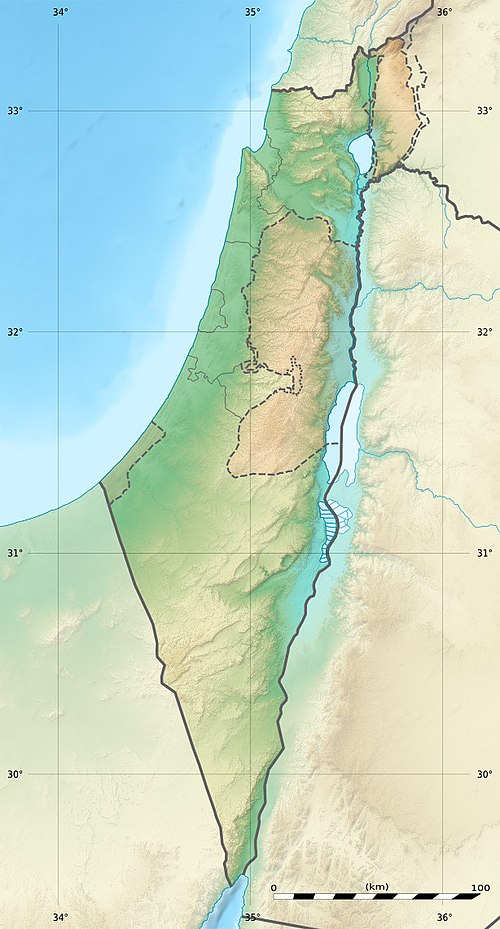Wedding at Cana
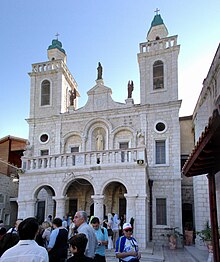
The transformation of water into wine at the wedding at Cana (also called the marriage at Cana, wedding feast at Cana or marriage feast at Cana) is the first miracle attributed to Jesus in the Gospel of John,[1][2] although none of the synoptic Gospels mentions the wedding at Cana.
In the Gospel account, Jesus Christ, his mother and his disciples are invited to a wedding. When his mother notices that the wine has run out, Jesus delivers a sign of his divinity by turning water into wine at her request. The location of Cana has been subject to debate among biblical scholars and archaeologists; several villages in Galilee are possible candidates.
The account is taken as evidence of Christ’s approval of marriage and earthly celebrations, and has also been used as an argument against teetotalism.
Biblical account[]
John 2:1–11[3] states that Jesus was at a wedding (Seudat Nissuin) in Cana with his disciples. Jesus' mother (unnamed in the Gospel of John) told Jesus, "They have no wine," and Jesus replied, "Woman, what concern is that to you and to me? My hour has not yet come." His mother then said to the servants, "Do whatever he tells you." (John 2:3–5).[4] Jesus ordered the servants to fill containers with water and to draw out some and take it to the chief steward (waiter). After tasting it, without knowing where it came from, the steward remarked to the bridegroom that he had departed from the custom of serving the best wine first by serving it last (John 2:6–10).[5] John adds that: "Jesus did this, the first of his signs, in Cana of Galilee, and it revealed his glory; and his disciples believed in him" (John 2:11).[6]
Interpretation[]
The Wedding Feast takes place in Cana shortly after the call of Philip and Nathanael. According to John 21:2, Cana was Nathanael's hometown.[7]
Although none of the synoptic Gospels mentions the wedding at Cana, Christian tradition based on John 2:11[8] holds that this is the first public miracle of Jesus.[9] It is considered to have symbolic importance as the first of the seven signs in the Gospel of John by which Jesus' divine status is attested, and around which the gospel is structured. Jesus will later return to Cana, where John 4:46–54 describes him healing a Capernaum official's young son; the second sign in the Gospel of John.[7]
The story has had considerable importance in the development of Roman Catholic theology. Bishop Fulton J. Sheen thought that it is very likely that it was one of Mary's relatives who was being married. This would mean Mary and her relatives would be embarrassed if they appeared inhospitable by running out of wine, giving Mary a reason to ask Jesus to intervene. Sheen further suggests that as Jesus arrived with additional guests, they may have contributed to the wines running short.[10] When his mother advises Jesus that their hosts are running out of wine, he says "Woman, what has this to do with me?" Sheen sees an echo of the Protevangelium of Genesis 3:15 "I will put enmity between you and the woman, and between your offspring and hers", marking the commencement of Jesus' redemptive ministry.[10] Jesus will again address her as "Woman" in John 19:26, when he entrusts his mother to his disciple John, "Woman, behold, your son."[7]
The gospel account of Jesus being invited to a wedding, attending, and using his divine power to save the celebrations from disaster are taken as evidence of his approval for marriage and earthly celebrations. It has also been used as an argument against the teetotalism practiced among certain Protestant Christian sects.[11]
Interpreted allegorically, the good news and hope implied by the story are in the words of the steward of the Feast when he tasted the good wine, "Everyone serves the good wine first, and then the inferior wine after the guests have become drunk. But you have kept the good wine until now" (John 2:10, RSV). This could be interpreted by saying simply that it is always darkest before the dawn, but good things are on the way. The more usual interpretation, however, is that this is a reference to the appearance of Jesus, whom the author of the Fourth Gospel regards as being himself "the good wine".[12] According to Bill Day, the miracle may also be interpreted as the antitype of Moses' first public miracle of changing water (the Nile river) into blood. This would establish a symbolic link between Moses as the first saviour of the Jews through their escape from Egypt and Jesus as the spiritual saviour of all people.[13]
Some commentators have speculated about the identity of the unnamed bridegroom. One tradition, represented by Thomas Aquinas among others, holds that the bridegroom was St John the Evangelist himself.[citation needed] Bishop John Spong suggests in his book Born of a Woman that the event was the wedding of Jesus himself to Mary Magdalene.[14] In 1854, at a time when polygamy was an element of mainstream practice of The Church of Jesus Christ of Latter-day Saints, the Latter-day Saint elder Orson Hyde made a similar suggestion, arguing that Jesus was a polygamist and that the event at Cana was his wedding to Mary Magdalene, Martha and Mary of Bethany.[15][16][17] However, the idea that Jesus was married to Mary Magdalene is usually dismissed by scholars as pseudohistorical.[18]
Studying Jesus in comparative mythology, the story of the transformation of water into wine bears some resemblance to a number of stories that were told about the ancient Greek god Dionysus, who among others was said to fill empty barrels that had been left locked inside a temple overnight with wine.[19] However, scholars generally agree that the Gospel of John was written by a community of Jewish Christians who had recently been excommunicated by the local synagogue for recognizing Jesus as the Messiah, leading some to conclude that it would be making it unlikely the possibility that the Gospel was influenced by ancient Greek mythology.[20] Bart Ehrman argues that the idea that the image of Jesus was influenced by ancient pagan mythology is usually dismissed by scholars as a fringe theory.[21]
The view of the valley view looking out towards Nazareth, from Khirbet Qana, would have predominantly been of grape vines, as archeologists have found evidence of first century wine production.[22] The early 6th century writer Antoninus Placentinus observed about Nazareth in his day: "it excels in wine and oil, fruits and honey."[23] So, if a miracle of turning water into wine had actually occurred at the site it would have likely have had allegorical significance for observers familiar with Greek mythology.
Identification of biblical Cana[]
The exact location of "Cana in Galilee" (Ancient Greek: Κανὰ τῆς Γαλιλαίας, Kana tēs Galilaias) has been subject to debate among scholars.[24] Modern scholars maintain that since the Gospel of John was addressed to Jewish Christians of the time, it is unlikely that the evangelist would mention a place that did not exist.[citation needed] However, Dominican scholar Jerome Murphy-O'Connor cautions that Cana is a very common name, with no known text offering any clue as to which of the dozen towns going by the name would be the correct one, and calls the common choice of Kafr Qanna near Nazareth "probably just a pious guess".[25]
The main candidates for the town from the Gospel of John are:
- Kafr Kanna, in Galilee[26]
- Khirbet Qana, also in Galilee, considered to be the more likely candidate[26][27]
- Qana, Southern Lebanon,[25] in an area that was part of historical Galilee
According to the Catholic Encyclopedia of 1914, a tradition dating back to the 8th century identifies Cana with the modern Arab town of Kafr Kanna, in Galilee, about 7 km (4.3 mi) northeast of Nazareth,[28] in today's Israel.
The ruined village of Khirbet Qana (Kanet el-Jelil), about 6 miles (9 km (5.6 mi)) further north,[29] is an option presented as certain by William F. Albright in 1923,[30] whose name "Qana" is also etymologically closer to Cana than "Kanna".[26]
Some Lebanese Christians, especially the Lebanese Melkites (Greek Catholics), supported by their Church, believe the southern Lebanese village of Qana to have been the actual location of this event.[25]
The spring of 'Ain Kanah ("Kanah Spring") near the village of Reineh, immediately northeast of Nazareth, has been proposed as an equally likely site by Conder in 1878,[31] but has little going for it and has been rejected in more recent scholarship as a candidate.[27]
Stone jars[]
Many throughout history have sought to recover the lost jars. On December 21, 2004, archaeologists reported finding in Kafr Kanna "pieces of large stone jars of the type the Gospel says Jesus used when he turned water into wine".[32] But American scientists excavating the rival site of Khirbet Qana north of it, also claimed to have found pieces of stone jars from the time of Jesus.[32] Fellow archaeologist Shimon Gibson cast doubt on the value of such finds for identifying the town meant by John, since such vessels are not rare and it would be impossible to link a particular set of vessels to the miracle.[32] "Just the existence of stone vessels is not enough to prove that this is a biblical site."[32] Several stone jars of the type described by the Gospel of John were found for instance in Jerusalem: "At least six of them stood in the basement kitchen of the [first-century CE] 'Burnt house'. They were shaped and finished on a very big lathe, given a pedestal foot and simple decoration. Such stone jars would hold large quantities of water for washing and kitchen needs. Flat discs of stone served as lids. The jars at Cana may have been similar to these", wrote Alan Millard.[33]
Wine or beer[]
In the journal Biblical Archaeology Review, Michael Homan argues that many biblical scholars have misinterpreted early texts, translating to 'wine' when the more sensible translation is 'beer'.[34] However, this has been dismissed by other writers, who point out that the Greek oinos always means wine, and that the word sikera was available if the gospel author wanted to refer to barley beer.[35][36][37]
In art[]
Depictions of The Wedding/Marriage at Cana are numerous in art history.

Marriage at Cana, c. 1500, Gerard David, Musée du Louvre, Paris

The calling of Apostle John at the Marriage at Cana, c. 1530, Jan Cornelisz Vermeyen
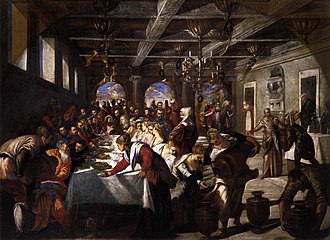
Marriage at Cana, 1561, Jacopo Tintoretto
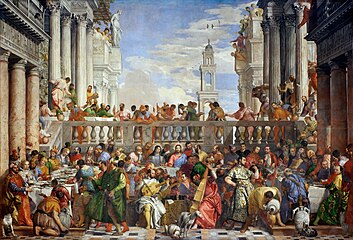
The Wedding Feast at Cana, 1563, Paolo Veronese, Musée du Louvre, Paris
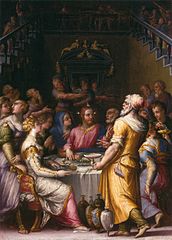
Marriage at Cana, 1566, Giorgio Vasari

Marriage at Cana by Giotto di Bondone, 14th century

Print about the Wedding at Cana. Made at the end of the 16th century. Preserved in the Ghent University Library.[38]

The Marriage at Cana by Maerten de Vos, c. 1596
Other[]
Sixth-century Irish missionary, Saint Columba of Iona, supposedly performed an identical miracle when he served as a deacon in Ireland under Finnian of Movilla, replenishing the supply of sacramental wine for a mass.[39]
See also[]
Further reading[]
- Knecht, Friedrich Justus (1910). . A Practical Commentary on Holy Scripture. B. Herder.
References[]
- ^ van der Loos, Hendrik (1965). The Miracles Of Jesus. Brill Archive. p. 590. GGKEY:ZY15HUEX1RJ.
- ^ Royster, Dmitri (1999). The Miracles of Christ. St Vladimir's Seminary Press. p. 71. ISBN 978-0-88141-193-5.
- ^ John 2:1–11
- ^ John 2:3–5
- ^ John 2:6–10
- ^ John 2:11
- ^ a b c Winstanley, Michael T. (2008). Symbols and Spirituality: Reflecting on John's Gospel. Don Bosco Publications. pp. 8–. ISBN 978-0-9555654-0-3.
- ^ John 2:11
- ^ Towner, W. S. (1996). "Wedding". In P. J. Achtermeier (ed.). Harper Collins Bible Dictionary. San Francisco: Harper. pp. 1205–1206.
- ^ a b Sheen, Fulton J. (1952). "The Marriage Feast At Cana, in The World's First Love". www.catholictradition.org.
- ^ Geisler, N. L. (1982). "A Christian Perspective on Wine-Drinking". Bibliotheca Sacra. 49.
- ^ Smith, D. M. (1988). "John". In Mays, J. L. (ed.). Harper's Bible Commentary. San Francisco: Harper. pp. 1044–1076.
- ^ Day, Bill (1997). The Moses Connection in John's Gospel. Mariner. ISBN 0-9662080-0-5.
- ^ Spong, John Shelby (1992). Born of a Woman. Harper. pp. 187–199.
- ^ Hyde, Orson (6 October 1854), "Conference message", Journal of Discourses, 2: 82
- ^ Abanes, Richard (2007). Inside Today's Mormonism. p. 239. ISBN 978-0-7369-1968-5.
- ^ Roberts, E (2011). A Disparity in Doctrine and Theology. p. 54. ISBN 978-1-4497-1210-5.
- ^ Ehrman, Bart D. (2004). Truth and Fiction in The Da Vinci Code: A Historian Reveals What We Really Know about Jesus, Mary Magdalene, and Constantine. USA: Oxford University Press. ISBN 978-0-19-518140-1.
- ^ Pollmann, Karla (2017). "Jesus Christ and Dionysus: Rewriting Euripides in the Byzantine Cento - Oxford Scholarship". Oxford Scholarship Online. doi:10.1093/acprof:oso/9780198726487.001.0001. ISBN 978-0-19-872648-7.
- ^ Hurtado, Larry W. (2005). How on Earth Did Jesus Become a God?: Historical Questions about Earliest Devotion to Jesus. Wm. B. Eerdmans. ISBN 978-0-8028-2861-3.
- ^ Ehrman, Bart D. (2012-03-20). Did Jesus Exist?: The Historical Argument for Jesus of Nazareth. Harper Collins. ISBN 978-0-06-208994-6.
- ^ Moore, Michael (2008-02-16). ""What good thing can come out of Nazareth?" (updated)". University of the Holy Land. Retrieved 2021-08-11.
- ^ Goor, Asaph (1966). "The History of the Grape-Vine in the Holy Land". Economic Botany. 20 (1): 46–64. doi:10.1007/BF02861926. ISSN 0013-0001. JSTOR 4252702. S2CID 44623301.
- ^ Charlesworth, James H. (2006). Jesus and Archaeology. Wm. B. Eerdmans. pp. 540–541. ISBN 978-0-8028-4880-2.
- ^ a b c Salameh, Rima (29 January 1994). "Lebanese Town Lays Claim To Jesus Christ's First Miracle". Tulsa World. Retrieved 21 June 2021 – via Associated Press.
- ^ a b c Reed, Jonathan L. (2000). Freedman, David Noel; Allen C. Myers (eds.). Cana (Gk. Kaná). Eerdmans Dictionary of the Bible. Amsterdam University Press. p. 212. ISBN 978-90-5356-503-2. Retrieved 15 July 2021.
- ^ a b Laney, J. Carl (1977). The Identification of Cana of Galilee (PDF). Selective Geographical Problems in the Life of Christ (doctoral dissertation) (Thesis). Dallas Theological Seminary. pp. 91–92. Retrieved 15 July 2021.
- ^ Ward, Bernard (1908). . In Herbermann, Charles (ed.). Catholic Encyclopedia. Vol. 3. New York: Robert Appleton Company.
- ^ Ward, Bernard (1908). "Cana". Catholic Encyclopedia. New York: Robert Appleton Co. Retrieved 16 July 2021 – via Catholic Answers.
- ^ Albright, W. F. (October 1923). "Some Archaeological and Topographical Results of a Trip through Palestine". Bulletin of the American Schools of Oriental Research. The University of Chicago Press on behalf of The American Schools of Oriental Research. 11 (11): 3–14 (see p. 11). doi:10.2307/1354763. JSTOR 1354763. S2CID 163409706.
- ^ Conder, Claude Reignier (1878). Tent Work in Palestine: A Record of Discovery and Adventure. R. Bentley & Son. p. 154.
- ^ a b c d "Archaeologist says she's found site of Jesus' first miracle". NBC News Digital. The Associated Press. 21 December 2004. Retrieved 15 July 2021.
- ^ Millard, Alan (1997). Discoveries from Bible Times: Archaeological Treasures Throw Light on the Bible. Lion Books. p. 184. ISBN 9780745937403. Retrieved 15 July 2021.
- ^ Homan, Michael M. (2010). "Did the Ancient Israelites Drink Beer?". Biblical Archaeology Review.
- ^ Kneale, Stephen (November 23, 2016). "Did Jesus actually turn water into beer?". Building Jerusalem.
- ^ Rao, Bandari Prabhaker (2010). The Missiological Motifs of the Miracles of Jesus Christ. ISPCK. p. 33. ISBN 9788184650259. Retrieved 14 April 2010.
- ^ Saarnivaara, Uuras (April 29, 2008). Can the Bible Be Trusted?: Old and New Testament Introduction and Interpretation. Wipf and Stock. ISBN 9781556356995.
- ^ "Bruiloft te Kana". lib.ugent.be. Retrieved 2020-09-28.
- ^ Adomnan of Iona (1995). Life of St Columba. Penguin.
External links[]
| Wikimedia Commons has media related to Marriage at Cana. |
- Land of Israel
- Gospel of John
- Jesus in art
- Kafr Kanna
- Luminous Mysteries
- Mary, mother of Jesus
- Miracles of Jesus
- Water and religion
- Wedding
- Winemaking
- Galilee
